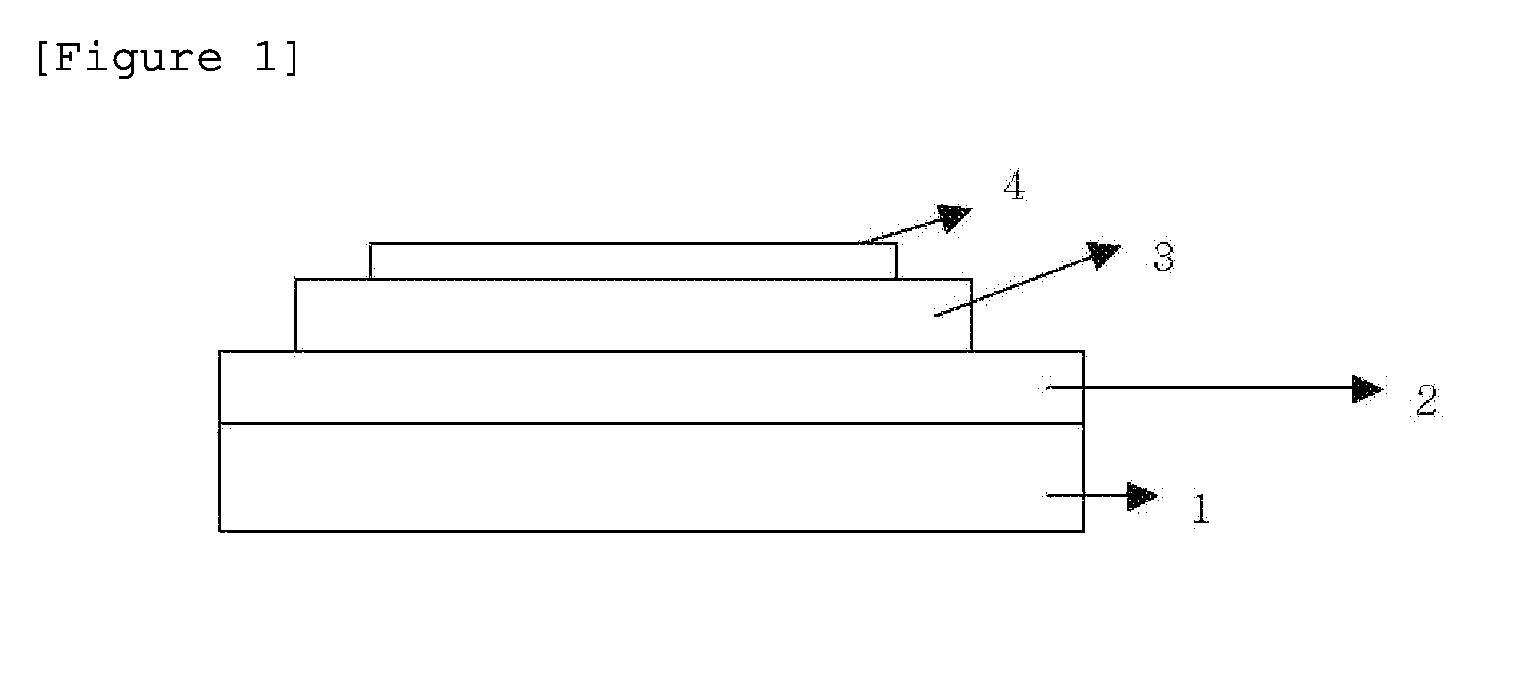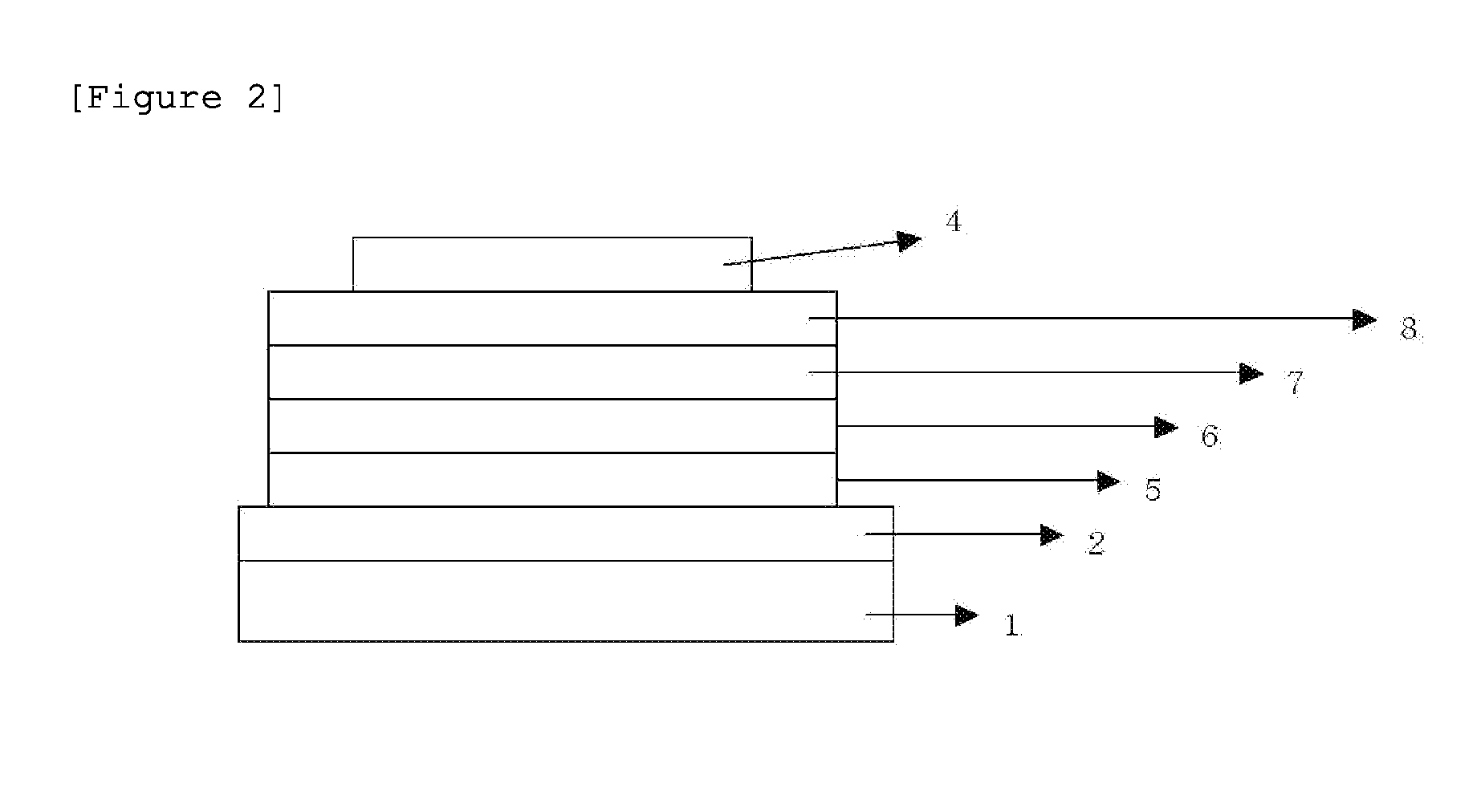Novel compound and organic light-emitting device using same
- Summary
- Abstract
- Description
- Claims
- Application Information
AI Technical Summary
Benefits of technology
Problems solved by technology
Method used
Image
Examples
synthetic example 1
Preparation Example 1
Preparation of the Material Represented by Formula 1-1-2
[0154]
[0155]
[0156]Benzo[a]carbazole (CAS No. 239-01-0) (20 g, 92.1 mmol), bromobenzene (15.9 g, 101 mmol), sodium tert-butoxide (11.5 g, 120 mmol), bis(tritert-butylphosphine)palladium (0.46 g, 0.9 mmol) and 300 ml of xylene were added to the 500 ml round bottom flask, and agitated and refluxed for 7 hours. Cooling was performed to normal temperature, and 20 g of cellite 545 was added thereto and agitated for 30 min. The reaction solution was filtered, and distilled under reduced pressure to concentrate. Recrystallization was performed by chloroform and ethanol to obtain compound 1 (21.5 g, 73.3 mmol) at a yield of 79.6%. MS: [M+H]+=294
[0157]
[0158]Compound 1 (18 g, 61.4 mmol) was added to 500 ml of the round bottom flask, and 350 ml of chloroform was added thereto, agitated and cooled to 0° C. N-bromosuccinimide (10.9 g, 61.4 mmol) was slowly added thereto, and then agitated at normal temperature for 5 hour...
preparation example 2
Preparation of the Material Represented by Formula 1-1-7
[0167]
[0168]
[0169]Compound 5 of Preparation Example 1 (5 g, 11.8 mmol), 2-bromo-9,9′-dimethylfluorene (CAS No. 28320-31-2) (3.6 g, 13.2 mmol), sodium tert-butoxide (1.5 g, 15.3 mmol), bis(tritert-butylphosphine)palladium (0.1 g, 0.2 mmol) and 100 ml of xylene were added to the 250 ml round bottom flask, and agitated and refluxed for 13 hours. Cooling was performed to normal temperature, and 6 g of cellite 545 was added thereto and agitated for 30 min. The reaction solution was filtered, and distilled under reduced pressure to concentrate. The column purification was performed to obtain Formula 1-1-7 (5.1 g, 8.3 mmol) at a yield of 70%. MS: [M+H]+=617
preparation example 3
Preparation of the Material Represented by Formula 1-2-14
[0170]
[0171]
[0172]8-bromo-11H-benzo[a]carbazole (CAS No. 21064-34-6) (30 g, 101.3 mmol), copper (powder, 3 μm; 12.9 g, 202.6 mmol), potassium carbonate (42 g, 303.9 mmol) and 90 ml of iodobenzene were added to the 250 ml round bottom flask, and agitated and refluxed for 12 hours. Cooling was performed to normal temperature, and 20 g of cellite 545 was added thereto and agitated for 30 min. The reaction solution was filtered, and distilled under reduced pressure to concentrate. Recrystallization was performed by ethanol to obtain compound 1 (30.5 g, 81.9 mmol) at a yield of 80.9%. MS: [M+H]+=373
[0173]
[0174]Compound 1 (29 g, 77.9 mmol), methyl anthranilate (12.9 g, 85.3 mmol), cesium carbonate (38 g, 116.6 mmol), bis(tritert-butylphosphine)palladium (0.4 g, 0.8 mmol) and 350 ml of toluene were added to the 500 ml round bottom flask, and agitated and refluxed for 7 hours. Cooling was performed to normal temperature, and 30 g of c...
PUM
| Property | Measurement | Unit |
|---|---|---|
| Fraction | aaaaa | aaaaa |
| Transport properties | aaaaa | aaaaa |
| Phosphorescence quantum yield | aaaaa | aaaaa |
Abstract
Description
Claims
Application Information
 Login to View More
Login to View More - R&D
- Intellectual Property
- Life Sciences
- Materials
- Tech Scout
- Unparalleled Data Quality
- Higher Quality Content
- 60% Fewer Hallucinations
Browse by: Latest US Patents, China's latest patents, Technical Efficacy Thesaurus, Application Domain, Technology Topic, Popular Technical Reports.
© 2025 PatSnap. All rights reserved.Legal|Privacy policy|Modern Slavery Act Transparency Statement|Sitemap|About US| Contact US: help@patsnap.com



